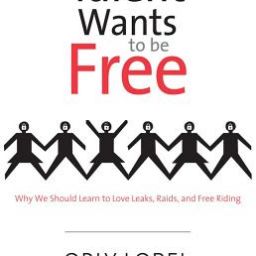
Anthea Kraut’s Choreographing Copyright: Race, Gender, and Intellectual Property Rights in American Dance (Oxford 2016) is an essential entry to the growing field of critical intellectual property studies. Kraut delves into the complex issues surrounding the granting (or not) of rights in dance in the United States, taking a complex historical view of the issue, delving into how power dynamics played a role in the judgment of the lines of protection, with the “dancer’s positions in a raced, gendered, and classed hierarchy, and on the historical conditions in which they made, and made claims on, on their dances.”
This is a readable academic book – and it gets the descriptions of law, both statutory and case law, right. Rather than damning with faint praise, this is a big deal, considering how often I read about legal disputes by those that are not law-trained and they get it so wrong. Kraut’s skill to blend together legal and dance descriptions manages to use words to describe dance and why those dances were at issue. I do wish that there was a companion site – even YouTube links to better see the steps described, rather than reliance on reading-based visualization.
The book delves into the Catch-22 that African-American creativity has frequently dealt with in the face of the limits of copyright protection, where copyright protects just enough to exclude certain creators and creativity, where white performers copied from Black performers, yet
“Under a racist power structure, these white performers invariably received top billing and greater remuneration than the African American performers from whom they borrowed. Record executives, meanwhile, routinely cheated black talent out of royalties. [Alberta] Hunter received her first copyright in 1922 for “Down Hearted Blues,” her most successful song[.] Yet for years, [she received no royalty payments]. … Without the (rhetorical) stamp of copyright to authorize Hunter’s version as an original, [one person’s] claim to be the inventor and exclusive exhibitor of the Black Bottom[, a vernacular African-American dance,] was capable of steamrolling evidence to the contrary. Asserting collective authorship was not enough for the law; a work had to be individually authored to qualify as intellectual property. Even unsubstantiated, Hunter’s copyright claim should thus be seen as a weapon against and check on white hegemony in the theatrical marketplace.” (148-49)
Kraut makes sure to remind the reader that the book is a series of case studies; because there isn’t much litigation in this area, it is difficult to draw the circles of influence too broadly. Every case study has interesting information about the state of the law: a dance dispute moving in the interstitial space between copyright and patent law: Fuller v. Gilmore, 121 F. 129 (C.C.S.D.N.Y. 1902); the reliance on the traditional dances of East Indians to create the early exotic dances by white women in the U.S.; how “’stealing’ []constituted a primary mode of learning and choreographic innovation for black vernacular dancers—a far cry from copyright law’s ideology of exclusive ownership” (137); how little even a famous choreographer like Agnes de Mille was paid for her groundbreaking choreography for Oklahoma! (199-200); how one striptease routine was denied copyright; and about the blending together of copyright and post-death rights-of-publicity-lite.
Favorite quote: “The threat of getting ‘whipped up’ and ‘tromped’ by a group of dancers must have carried at least as urgent a force as law.” (141)
The chapter on Johnny Hudgins, a Black blackface performer who both argued for the uniqueness and copyrightability of his dances – as well as the complete opposite, reminded me of the swirling storm of lawsuits regarding the unique sound of George Clinton and P-Funk. This case was considered historic in the Black press, where “the fact that a black performer’s originality was being adjudicated at all was something of a coup.” (107) Kraut doesn’t shirk away from making bold statements like: “the relationship between the original and the copy in American performance is [] haunted by the legacy of slavery and its cultural corollary, minstrelsy.” (98). It would be enlightening to have Kraut collaborate with a music scholar to delve into the twists and turns creative artists take to protect or declaim their work during various part of their careers, especially with her brief mention of the work-for-hire doctrine in copyright law and the contract disputes frequently at issue for performers.
The book does touch on the present, with mentions of the Fair Use Best Practices for Dance by the Dance Heritage Coalition. However, this section is the only disappointment, perhaps due to its clinginess to relevance, with its focus on Beyoncé. Beyoncé’s career is far from its end; talking about one aspect of her problematic connection to borrowing/copyright seems half-finished. The earlier sections of the book were able to successfully engage with how copyright potentially influenced the entire careers of dancers – and in the case of Martha Graham, her “afterlife” in her dances owned by her namesake studio.
The idea that the input of women, people of color, and specifically the work of women of color in the construction and application of copyright law isn’t surprising, but it is so rarely written about in mainstream law-related publications. The issues covered by Kraut are surprising that they haven’t been covered before – but yet not surprising. Even looking at law review articles before the internet age (so before 1990), there were less than two dozen articles that focused on the possibility of copyright in choreography – and the first law review article from a similar perspective from Kraut appears to be this one (which does cite Kraut’s earlier work) – from 2012: Caroline Joan S. Picart, A Tango between Copyright and Choreography: Whiteness as Status Property in Balanchine’s Ballets, Fuller’s Serpentine Dance and Graham’s Modern Dances, 18 Cardozo J.L. & Gender 685 (2012). Kraut cites Picart and another legal scholar, Julie Van Camp, in her background section, as the two scholars who “attempted to create a bridge between dance studies and legal scholarship on copyright.” (37)
Considering Kraut doesn’t write from the perspective of a law-trained person, the extreme dearth of similar publications from those that are is stark – there are multiple articles on the copyright of comedy or magic (or cooking or tattoos), but somehow the complex history of dance copyright escapes much notice. But this is true for other performative elements outside of the high culture white straight male mainstream (with the exception of roller derby names and flash mobs (and fashion is both in and out of these circles)): the only U.S. published law review article on the intellectual property rights in or not in drag performance specifically focuses on Israeli drag! Eden Sarid, Don’t Be a Drag, Just Be a Queen – How Drag Queens Protect Their Intellectual Property without Law, 10 FIU L. Rev. 133 (2014) .
While present indigenous rights are a hot subject in intellectual property study, thinking and studying about how we got to here within the United States regarding cultures that have had their power to control “intellectual property rights” stripped over time as part of general disempowerment efforts, specifically African-Americans and Native Americans/First Peoples also need to be told. We’ve read and seen much on what happens when borrowing and parody culture bumps into permissions and control culture surrounding hip-hop and other forms of culture bubbling up from the African-American experience, primarily focused on Campbell v. Acuff-Rose. Kraut expands this universe of complex dynamics complicating our understanding of the bounds of copyright to reflect on dance, and I commend her skill and time commitment to do this story justice. I hope to read many more books and articles on these contested areas on the boundary lines of intellectual property law.
Summary: Highly recommended for its excellent historicalizing of copyright’s view of dance in the U.S. Would be great in use in classes focusing on I.P. history, copyright law, critical intellectual property, American history, cultural studies, and more.



